PERPENDICULAR BISECTOR THEOEREM OF A TRIANGLE
Subscribe to our ▶️ YouTube channel 🔴 for the latest videos, updates, and tips.
If a point is on the perpendicular bisector of a segment, then it is equidistant from the endpoints of the segment.
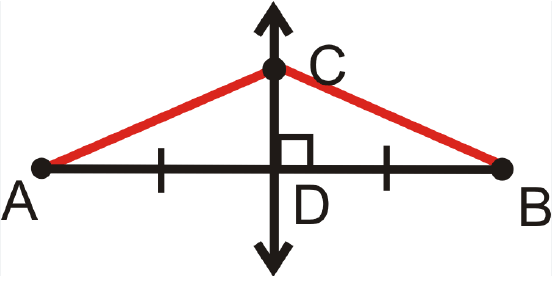
Consider two triangles, ADC and BCD.
∠ADC = ∠BDC (90 degree angle)
AD = BD (Bisector)
CD = CD (Common)
By CPCTC (Corresponding parts congruence triangle)
AC = BC
Subscribe to our ▶️ YouTube channel 🔴 for the latest videos, updates, and tips.
Problem 1 :
Find the measure of RT and RV.
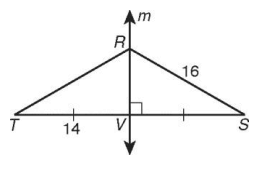
Solution :
In triangle RTV and RVS.
∠RVT = ∠RVS (90°)
TV = VS (Bisector)
RV = RV (Common)
By CPCTC
TR = 16
TR2 = TV2 + VR2
162 = 142 + VR2
VR2 = 256 - 196
VR2 = 60
VR = √60
VR = 2√15
Problem 2 :
Find the measure of HJ
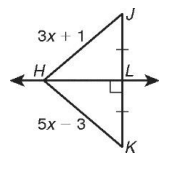
Solution :
Here HL is perpendicular bisector,
In triangle HLJ and HLK.
∠HLJ = ∠HLK (90°)
LJ = LK (Bisector)
HL = HL (Common)
By CPCTC
HJ = HK
3x + 1 = 5x - 3
3x - 5x = -3 - 1
-2x = -4
x = 2
Applying the value of x, we get
HJ = 3(2) + 1
HJ = 7
Problem 3 :
Find the measure of FG.
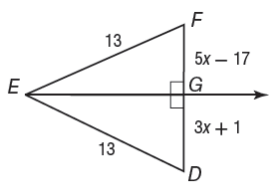
Solution :
FG = GD
5x - 17 = 3x + 1
5x - 3x = 1 + 17
2x = 18
x = 9
Applying the value of x, we get
FG = 5(9) - 17
FG = 45 - 17
FG = 28
Problem 4 :
Find x and y.
a) m∠ADB = (7x + 27), find x
b) BC = (3y – 7), BD = (y + 3). Find y.
Here AD is perpendicular bisector.
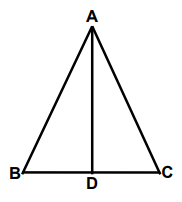
Solution :
a)
m∠ADB = (7x + 27)
m∠ADB = 90
7x + 27 = 90
7x = 63
x = 63/7
x = 9
b) BC = (3y – 7), BD = (y + 3)
Since AD is perpendicular bisector, BD = DC
2BD = BC
2(y + 3) = 3y - 7
2y + 6 = 3y - 7
2y - 3y = -7 - 6
-y = -13
y = 13
Problem 5 :
DE is the perpendicular bisector of AC.
|
i) AB = _____________ ii) AE = _____________ iii) AD = _____________ |
iv) BC = ______________ v) AC = ______________ vi) CD = ______________ |
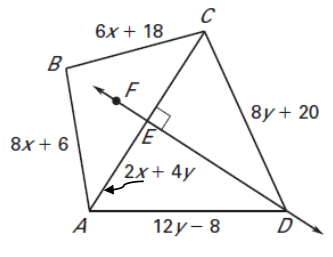
Solution :
Since DE is perpendicular bisector, AE = EC
In triangles AED and DEC,
AD = DC
12y - 8 = 8y + 20
12y - 8y = 20 + 8
4y = 28
y = 7
In triangles ABE and BEC,
AB = BC
8x + 6 = 6x + 18
8x - 6x = 18 - 6
2x = 12
x = 12
|
i) AB = 8x + 6 = 8(12) + 6 = 96 + 6 = 102 |
ii) AE = 2x + 4y = 2(12) + 4(7) = 24 + 28 = 52 |
|
iii) AD = 12y - 8 = 12(7) - 8 = 84 - 8 = 76 |
iv) BC = 6x + 18 = 6(12) + 18 = 72 + 18 = 90 |
|
v) AC = 2AE AC = 2(2x + 4y) = 2 [2(12) + 4(7)] = 2 [24 + 28] = 2 (52) = 104 |
vi) CD = 8y + 20 = 8(7) + 20 = 56 + 20 = 76 |
Problem 6 :
XY is perpendicular bisector of RS and TU
|
i) XS = ii) XT = iii) TU = |
iv) ZS = v) TR = |
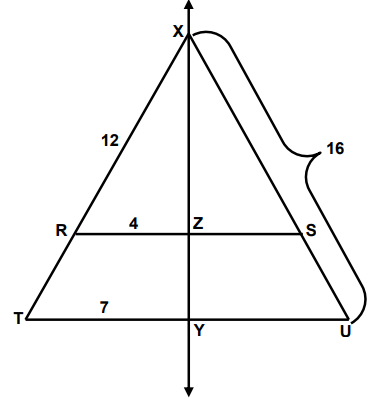
Solution :
XU = XS + SU
XS = 12 = XR
16 = 12 + SU
SU = 16 - 12
SU = 4
i) XS = 12
ii) XT = 16
iii) TU = TY + YU
= 7 + 7
TU = 14
iv) ZS = 4 = RZ
v) TR = 4 = SU
Problem 7 :
use the diagrams to solve for the unknown variables x and y.
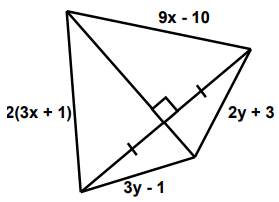
Solution :
|
2(3x + 1) = 9x - 10 6x + 2 = 9x - 10 6x - 9x = -10 - 2 -3x = -12 x = 4 |
3y - 1 = 2y + 3 3y - 2y = 3 + 1 y = 4 |
Problem 8 :
CD is the Perpendicular Bisector of AB If
AC = 6x + 9 and CB = 2x + 33
find BC.
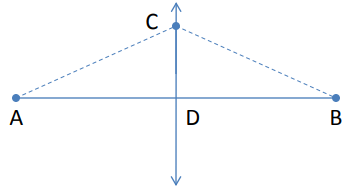
Solution :
AC = BC
6x + 9 = 2x + 33
6x - 2x = 33 - 9
4x = 24
x = 24/4
x = 6
Applying the value of x.
BC = 2(6) + 33
= 12 + 33
= 45
Recent Articles
-
Finding Range of Values Inequality Problems
May 21, 24 08:51 PM
Finding Range of Values Inequality Problems -
Solving Two Step Inequality Word Problems
May 21, 24 08:51 AM
Solving Two Step Inequality Word Problems -
Exponential Function Context and Data Modeling
May 20, 24 10:45 PM
Exponential Function Context and Data Modeling